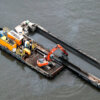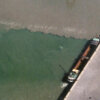Wetlands are a natural coastal habitat with unique species of flora and fauna that protect against erosion and flooding of nearby communities.
Wetlands ecosystem
Although a small percentage of the earth’s surface, wetlands contain important ecosystems that impact human life. They function as regulators of water regimes and water storage and help with flood prevention and natural water treatment. They represent habitats with great biodiversity and help maintain typical submerged water communities in seas, rivers, marshes and lakes. They support many species of birds and mammals, fish, amphibians, shellfish and insects, as their habitat or during migration and breeding season.
Wetlands also contribute to many key economic and social values.
As early as the 1970s scientific awareness of the value of wetlands led to the formation of the Ramsar Convention.
The Ramsar Convention
The Ramsar Convention, named after the city of Ramsar in Iran, where the Convention was signed in 1971. It is the first global intergovernmental treaty on conservation and sustainable use of wetlands. It is also known as the Convention on Wetlands.
Almost 90% of United Nations member states, from all the world’s geographic regions, have acceded to become “Contracting Parties” since its inception – an indication of the seriousness with which the world views the protection of wetlands.
The Ramsar Convention defines wetlands as “areas of marsh, fen, peat land or water, whether natural or artificial, permanent or temporary, with water that is static or flowing, fresh, brackish or salt, including areas of marine water the depth of which at low tide does not exceed six metres”.
Whereabouts of wetlands
Wetlands are present all over the world and are typically divided into five types:
- estuaries, where rivers meet the sea and salinity is intermediate between salt and freshwater such as deltas, mudflats and salt marshes
- marine, that is, areas not influenced by river flows like coastlines and coral reefs
- riverine, where rivers periodically inundate land such as meadows, flooded forests, oxbow lakes and river forelands)
- palustrine, places where water is rather permanent as in papyrus swamps, marshes and fens
- lacustrine, areas where water is permanent but does not really flow such as ponds, kettle lakes and volcanic crater lakes.
Dredging and wetlands
The global need for economic expansion along the coast, be it for navigation, port development, residential or recreational uses has put pressure on wetlands everywhere. As much of this marine development involves the dredging industry, the need for research and regulation within the industry has grown.
While governmental and non-governmental agencies continue to establish guidelines for dredging activities near wetlands, the dredging industry has also researched methods of work that ensure an environmental and economic balance.
Situations to consider when working near wetlands include:
- deepening navigation channels for the increasing draught of ocean-going vessels can increase salt water intrusion from the sea
- fresh water withdrawal from waterways also causes the salt content to rise, resulting in higher salt concentration in the plain, which can kill trees and other plants.
- the flow of sand and / or contaminants toward the area which stunts growth of the habitat.
With proper planning, dredging can avoid creating these situations. Or where damaged wetlands exist, dredging can be used to remedy the situation. Strategic management of wetland areas is necessary from the start of a port or other maritime project. Prevention of negative impacts or compensation for them is possible.
In areas that have already been impacted, restoration of sand banks and land reclamation can re-establish wetlands and encourage the return of species that have been harmed by development.
In some cases, compensation for lost wetlands can be achieved by the strategic placement of clean dredged material. This dredged sediment can add to the growth of wetlands and help attract bird and animal life back to the area. For instance, using dredged material to create riverine islands has been proven successful.
Economic value of wetlands
Wetland restoration planning is similar to other infrastructure planning only more complex. Issues can be hydrological, nautical and ecological. Many stakeholders with different interests add to the need for adequate spatial planning, and attention to environmental and social issues and to legal requirements.
In the past the valuation of wetlands measured against that of economic development was difficult to establish. Nowadays, with the advent of the Ecosystem Services approach, the value of wetlands can be expressed in financial terms and weighed against the value of development. For example, commercial fisheries and recreational facilities are often near wetlands. The destruction or deterioration of wetlands would not only be a loss of habitat and biodiversity, it would also mean the loss of valuable economic assets.
TAGS
Subjects
Environment
-
 Building with Nature
Building with Nature
-
 Climate Change
Climate Change
-
 CO2 & Other Emissions / Greenhouse Gases
CO2 & Other Emissions / Greenhouse Gases
-
 Coastal Protection
Coastal Protection
-
 Confined Disposal Facilities
Confined Disposal Facilities
-
 Coral Reefs
Coral Reefs
-
 Deltas
Deltas
-
 Ecosystem Services
Ecosystem Services
-
 Environmental Impact Assessment
Environmental Impact Assessment
-
 Environmental Monitoring
Environmental Monitoring
-
 Environmental Monitoring and Management Plans
Environmental Monitoring and Management Plans
-
 Flood Defence
Flood Defence
-
 Management Practices for the Environment
Management Practices for the Environment
-
 Mangroves
Mangroves
-
 Remediation dredging (Contaminated sediments)
Remediation dredging (Contaminated sediments)
-
 Sustainability
Sustainability
-
 Turbidity
Turbidity
-
 Underwater Sound
Underwater Sound
-
 Wetlands
Wetlands






